初中语法知识点学案_lesson46时间状语从句
文档属性
| 名称 | 初中语法知识点学案_lesson46时间状语从句 | 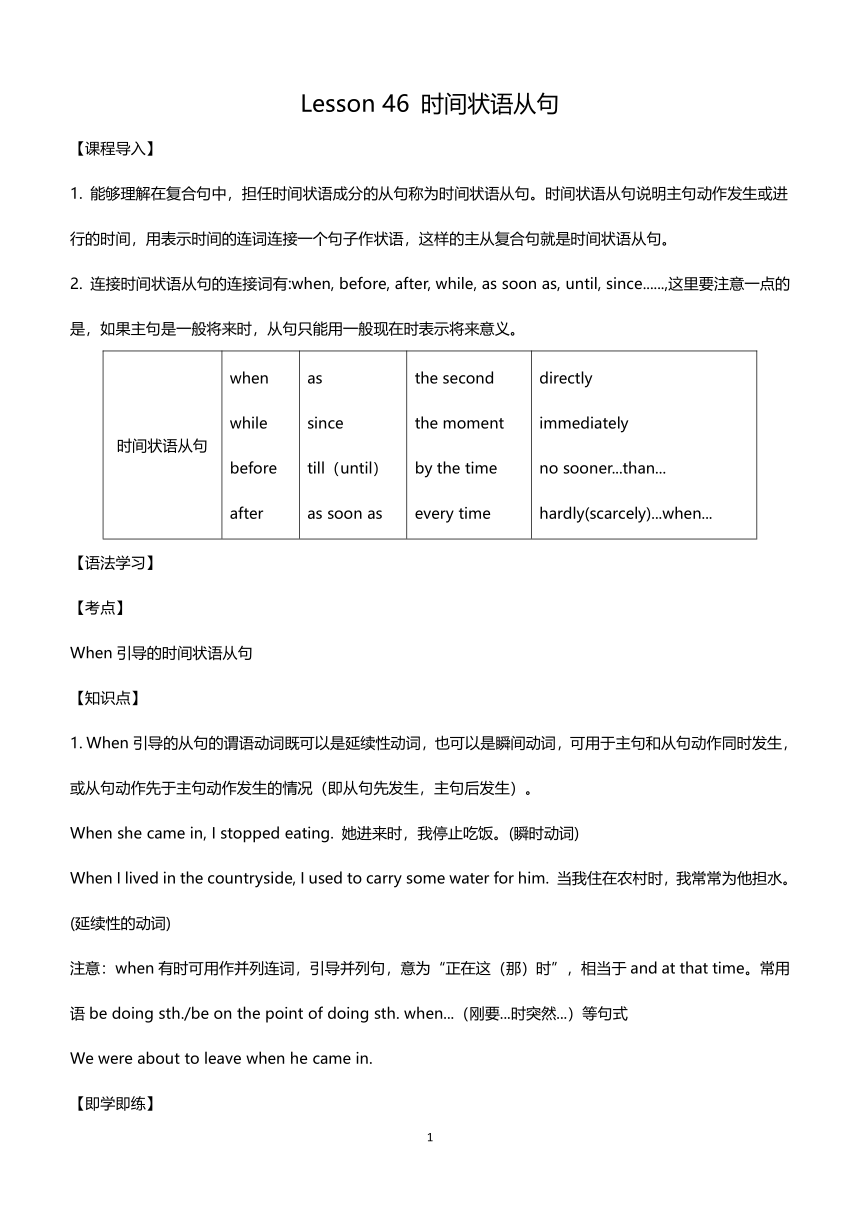 | |
| 格式 | docx | ||
| 文件大小 | 28.7KB | ||
| 资源类型 | 试卷 | ||
| 版本资源 | 通用版 | ||
| 科目 | 英语 | ||
| 更新时间 | 2021-08-18 14:06:06 | ||
图片预览

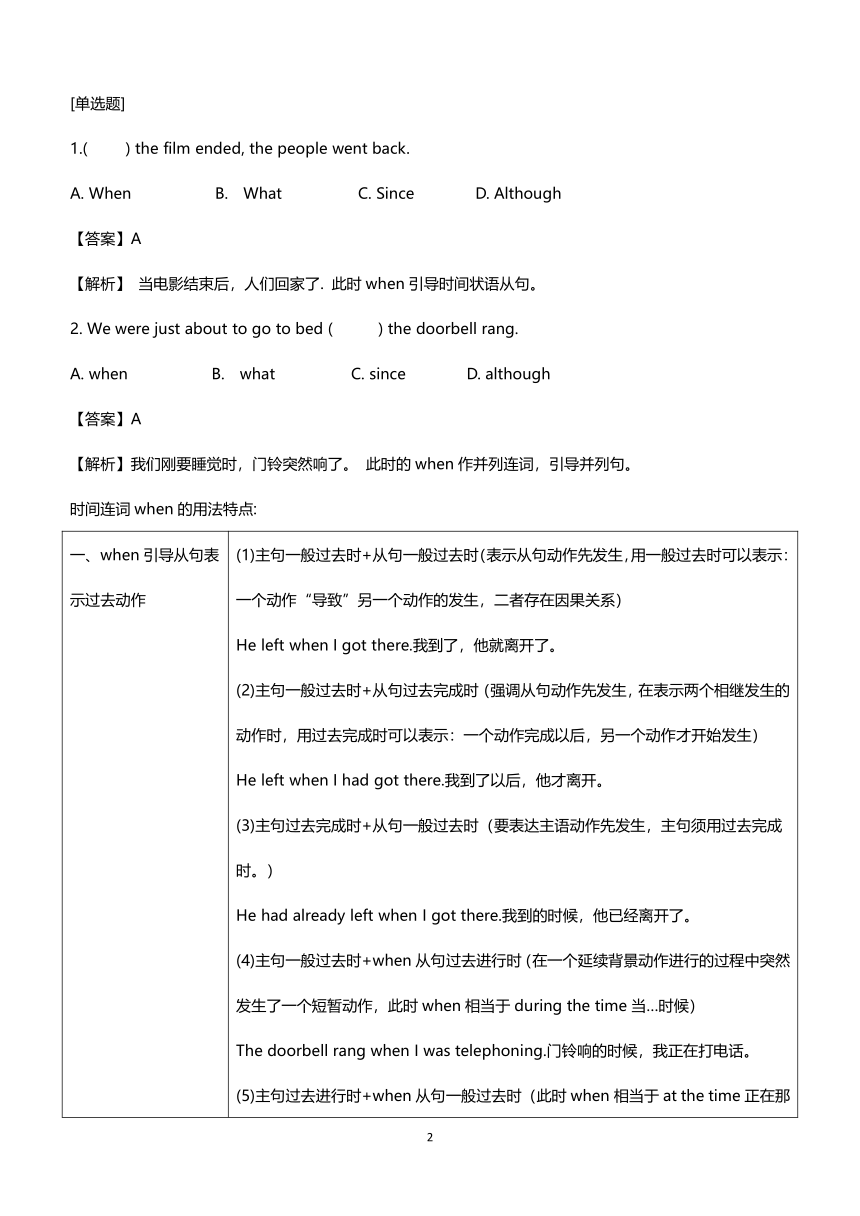
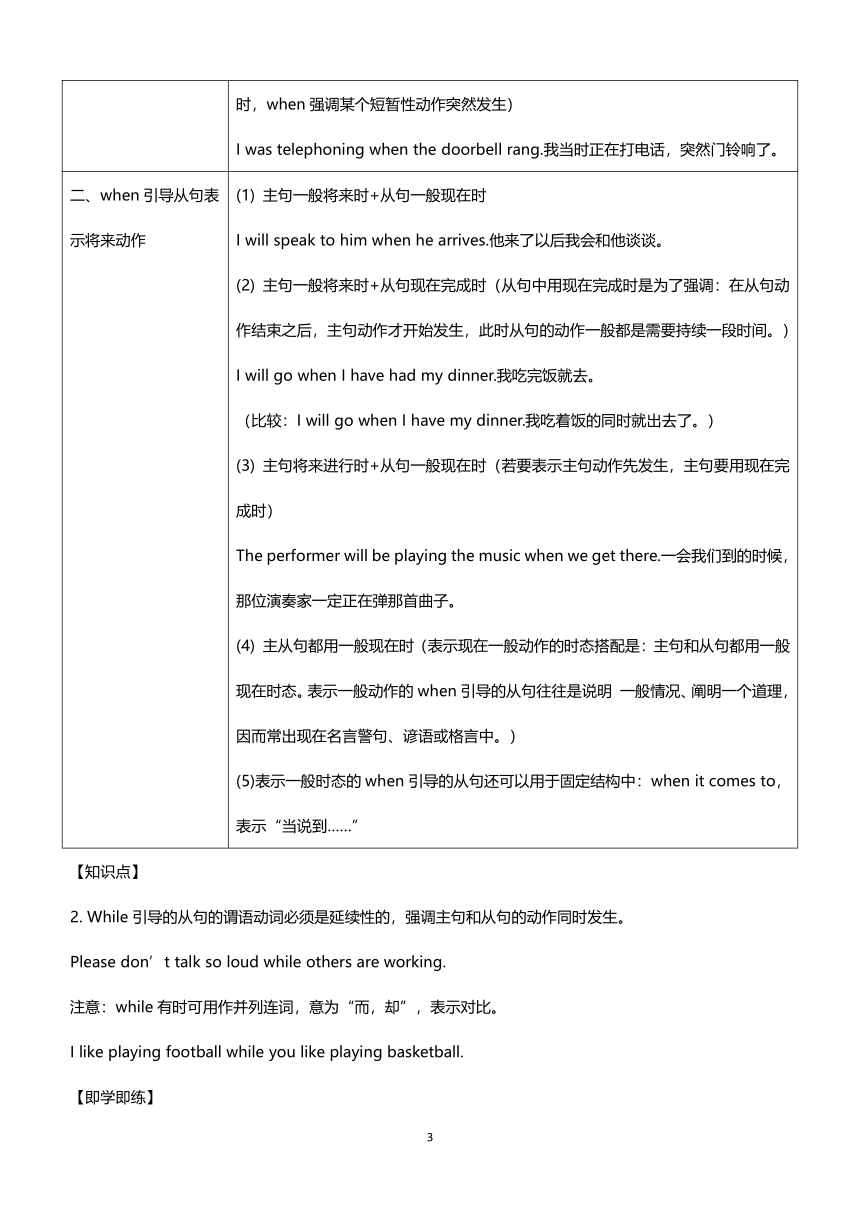
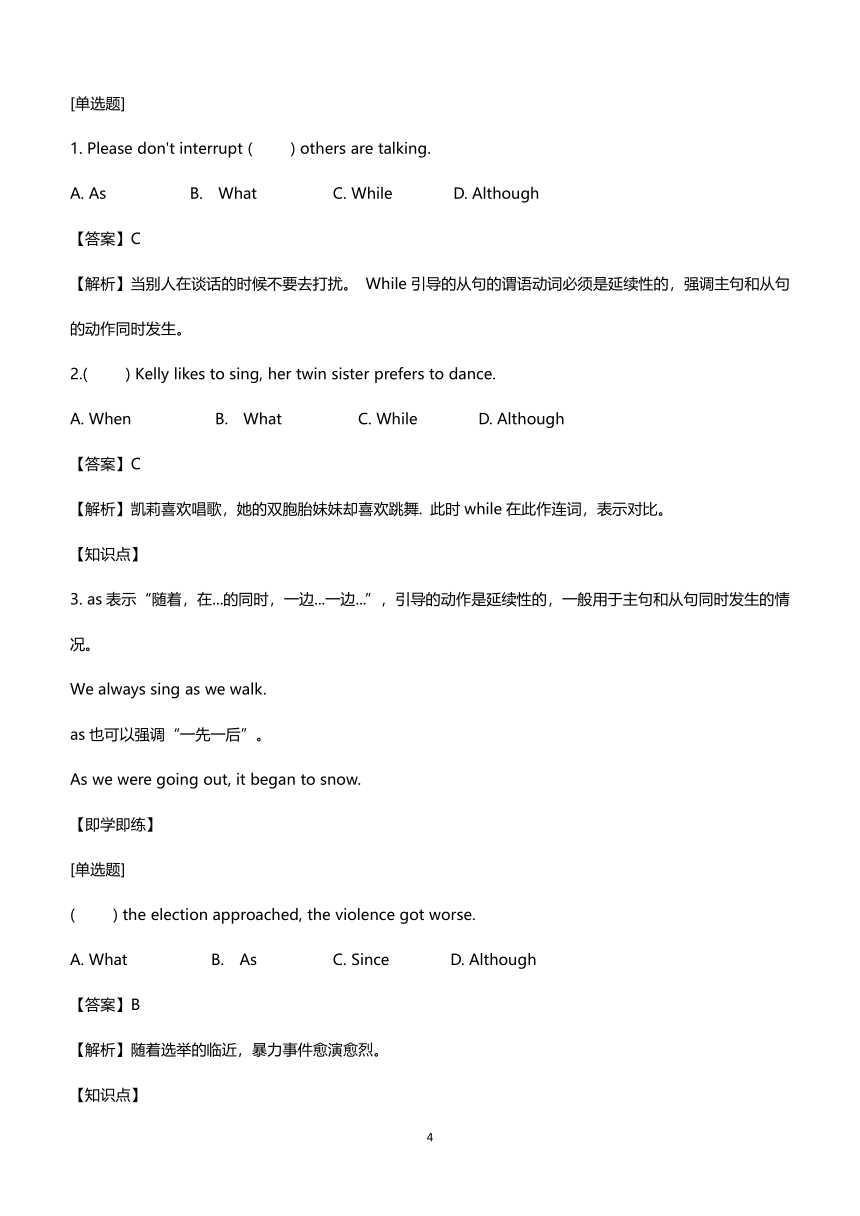
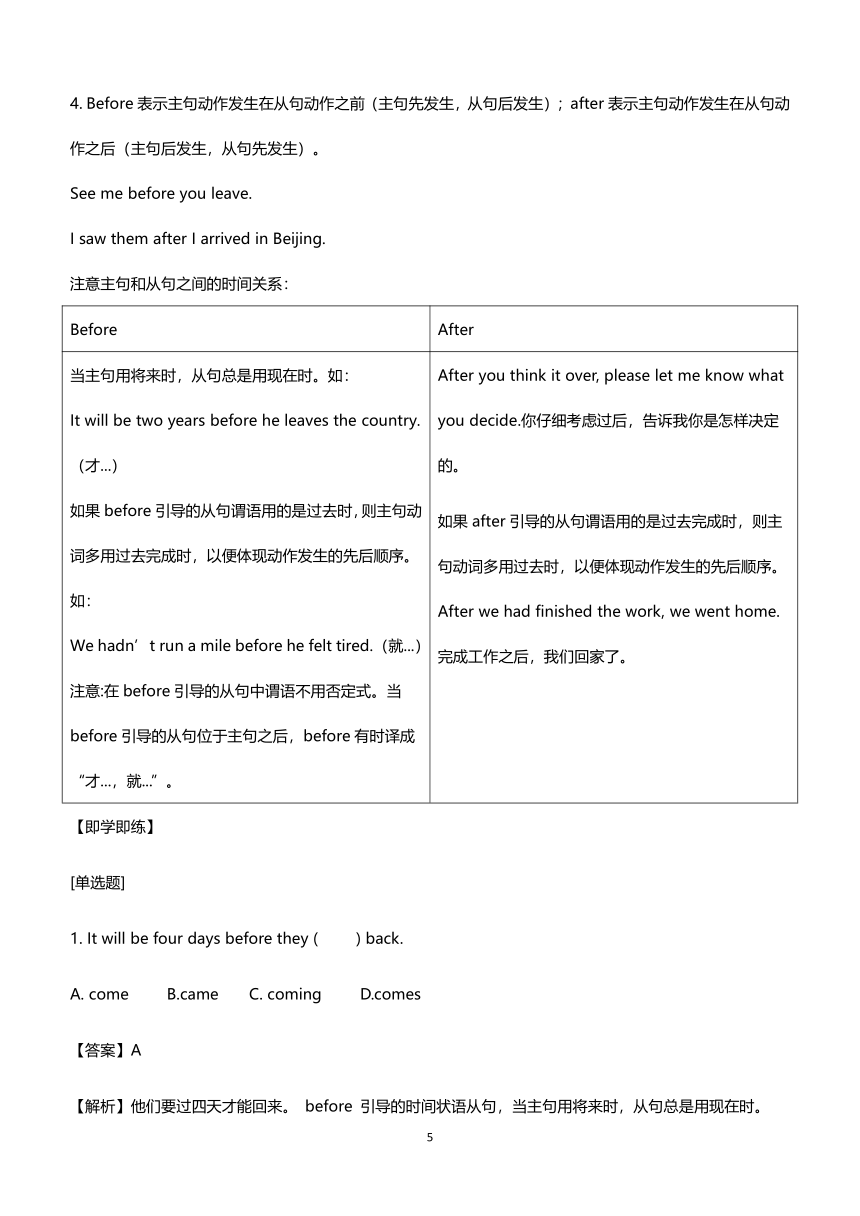
文档简介
Lesson 46 时间状语从句
【课程导入】
1. 能够理解在复合句中,担任时间状语成分的从句称为时间状语从句。时间状语从句说明主句动作发生或进行的时间,用表示时间的连词连接一个句子作状语,这样的主从复合句就是时间状语从句。
2. 连接时间状语从句的连接词有:when, before, after, while, as soon as, until, since......,这里要注意一点的是,如果主句是一般将来时,从句只能用一般现在时表示将来意义。
时间状语从句
when
while
before
after
as
since
till(until)
as soon as
the second
the moment
by the time
every time
directly
immediately
no sooner...than...
hardly(scarcely)...when...
【语法学习】
【考点】
When引导的时间状语从句
【知识点】
1. When引导的从句的谓语动词既可以是延续性动词,也可以是瞬间动词,可用于主句和从句动作同时发生,或从句动作先于主句动作发生的情况(即从句先发生,主句后发生)。
When she came in, I stopped eating. 她进来时,我停止吃饭。(瞬时动词)
When I lived in the countryside, I used to carry some water for him. 当我住在农村时,我常常为他担水。(延续性的动词)
注意:when有时可用作并列连词,引导并列句,意为“正在这(那)时”,相当于and at that time。常用语be doing sth./be on the point of doing sth. when...(刚要...时突然...)等句式
We were about to leave when he came in.
【即学即练】
[单选题]
1.( ) the film ended, the people went back.
A. When B. What C. Since D. Although
【答案】A
【解析】 当电影结束后,人们回家了. 此时when引导时间状语从句。
2. We were just about to go to bed ( ) the doorbell rang.
A. when B. what C. since D. although
【答案】A
【解析】我们刚要睡觉时,门铃突然响了。 此时的when作并列连词,引导并列句。
时间连词when的用法特点:
一、when引导从句表示过去动作
(1)主句一般过去时+从句一般过去时(表示从句动作先发生,用一般过去时可以表示:一个动作“导致”另一个动作的发生,二者存在因果关系)
He left when I got there.我到了,他就离开了。
(2)主句一般过去时+从句过去完成时(强调从句动作先发生,在表示两个相继发生的动作时,用过去完成时可以表示:一个动作完成以后,另一个动作才开始发生)
He left when I had got there.我到了以后,他才离开。
(3)主句过去完成时+从句一般过去时(要表达主语动作先发生,主句须用过去完成时。)
He had already left when I got there.我到的时候,他已经离开了。
(4)主句一般过去时+when从句过去进行时(在一个延续背景动作进行的过程中突然发生了一个短暂动作,此时when相当于during the time当…时候)
The doorbell rang when I was telephoning.门铃响的时候,我正在打电话。
(5)主句过去进行时+when从句一般过去时(此时when相当于at the time正在那时,when强调某个短暂性动作突然发生)
I was telephoning when the doorbell rang.我当时正在打电话,突然门铃响了。
二、when引导从句表示将来动作
(1) 主句一般将来时+从句一般现在时
I will speak to him when he arrives.他来了以后我会和他谈谈。
(2) 主句一般将来时+从句现在完成时(从句中用现在完成时是为了强调:在从句动作结束之后,主句动作才开始发生,此时从句的动作一般都是需要持续一段时间。)
I will go when I have had my dinner.我吃完饭就去。
(比较:I will go when I have my dinner.我吃着饭的同时就出去了。)
(3) 主句将来进行时+从句一般现在时(若要表示主句动作先发生,主句要用现在完成时)
The performer will be playing the music when we get there.一会我们到的时候,那位演奏家一定正在弹那首曲子。
(4) 主从句都用一般现在时(表示现在一般动作的时态搭配是:主句和从句都用一般现在时态。表示一般动作的when引导的从句往往是说明 一般情况、阐明一个道理,因而常出现在名言警句、谚语或格言中。)
(5)表示一般时态的when引导的从句还可以用于固定结构中:when it comes to,表示“当说到……”
【知识点】
2. While引导的从句的谓语动词必须是延续性的,强调主句和从句的动作同时发生。
Please don’t talk so loud while others are working.
注意:while有时可用作并列连词,意为“而,却”,表示对比。
I like playing football while you like playing basketball.
【即学即练】
[单选题]
1. Please don't interrupt ( ) others are talking.
A. As B. What C. While D. Although
【答案】C
【解析】当别人在谈话的时候不要去打扰。 While引导的从句的谓语动词必须是延续性的,强调主句和从句的动作同时发生。
2.( ) Kelly likes to sing, her twin sister prefers to dance.
A. When B. What C. While D. Although
【答案】C
【解析】凯莉喜欢唱歌,她的双胞胎妹妹却喜欢跳舞. 此时while在此作连词,表示对比。
【知识点】
3. as表示“随着,在...的同时,一边...一边...”,引导的动作是延续性的,一般用于主句和从句同时发生的情况。
We always sing as we walk.
as也可以强调“一先一后”。
As we were going out, it began to snow.
【即学即练】
[单选题]
( ) the election approached, the violence got worse.
A. What B. As C. Since D. Although
【答案】B
【解析】随着选举的临近,暴力事件愈演愈烈。
【知识点】
4. Before表示主句动作发生在从句动作之前(主句先发生,从句后发生);after表示主句动作发生在从句动作之后(主句后发生,从句先发生)。
See me before you leave.
I saw them after I arrived in Beijing.
注意主句和从句之间的时间关系:
Before
After
当主句用将来时,从句总是用现在时。如:
It will be two years before he leaves the country.(才...)
如果before引导的从句谓语用的是过去时,则主句动词多用过去完成时,以便体现动作发生的先后顺序。如:
We hadn’t run a mile before he felt tired.(就...)
注意:在before引导的从句中谓语不用否定式。当before引导的从句位于主句之后,before有时译成“才...,就...”。
After you think it over, please let me know what you decide.你仔细考虑过后,告诉我你是怎样决定的。
如果after引导的从句谓语用的是过去完成时,则主句动词多用过去时,以便体现动作发生的先后顺序。
After we had finished the work, we went home.完成工作之后,我们回家了。
【即学即练】
[单选题]
1. It will be four days before they ( ) back.
A. come B.came C. coming D.comes
【答案】A
【解析】他们要过四天才能回来。 before 引导的时间状语从句,当主句用将来时,从句总是用现在时。
2. My father ( ) for Canada just before the letter arrived.
A. leaves B. left C.has left D. had left
【答案】D
【解析】我父亲恰好在信到之前去加拿大了。 before引导的从句谓语用的是过去时,则主句动词多用过去完成时,以便体现动作发生的先后顺序。
3. After he had finished the novel, he( ) on a trip.
A. had gone B. has gone C.went D. goes
【答案】C
【解析】 他写完小说后,就去旅行了。 如果after引导的从句谓语用的是过去完成时,则主句动词多用过去时,以便体现动作发生的先后顺序。
【知识点】
5. till和until
一般情况下两者可以互换,但是在强调句型中多用until,till不可以用在句首,而until可以放在句首。
用于肯定句时,主句动作是延续性动词,表示“某动作或状态一直持续到 某时间点才停止”;
用于否定句时,主句动词是非延续性动词(即瞬时动词),从句为肯定句式,表示“某动作直到某时间才开始”。
We waited until he came.
He won’t go to bed till(until) she returns.
注意:放在句首时通常用until的形式。till在口语中更为常见。
Until you told me I had no idea of it.
【即学即练】
[单选题]
根据中文意思选择恰到的词
I didn't go to bed( ) my father came back. (直到我父亲回来我才上床睡觉。)
A. while B. when C.until D. since
【答案】C
【解析】带入B选项的中文意思是:我父亲回来的时候我没有睡觉,带入D选项的中文意思是:自从我父亲回来后我就没睡过觉。While引导的从句的谓语动词必须是延续性的,强调主句和从句的动作同时发生,不符合原意。故选C。
【知识点】
6. Since表示“自...以来,自...以后”,引导的从句的谓语动词可以是延续性的动词,也可以是瞬间动词。一般情况下,从句谓语动词用一般过去时,而主句的谓语动词用现在完成时。但在“it is+时间+since从句”的句型中,主句多用一般现在时。
He hasn’t seen his father since he was born.
It is 3 years since she joined the army.
【即学即练】
[填空题]
It is four years ( ) my sister lived in Beijing. 我妹妹不在北京住有四年了。
【答案】since
【解析】表示“自...以来,自...以后”,引导的从句的谓语动词可以是延续性的动词,也可以是瞬间动词。
时间连词since的用法特点:
结构
例句
1.现在完成时态+since+短暂动词的一般过去时
I have worked in this company since I graduated.自从我毕业,就一直在这家公司上班。
2.现在完成时态+since+延续动词的一般过去时(since后用延续动词的一般过去时,表示从句动作“结束”以来,主句活动还在持续)
He hasn’t contacted me since I worked in that company.自从我离开那家公司以后,他就再没有和我联系过。
3.现在完成时态+since+延续动词的现在完成时(since后用延续动词的现在完成时,表示从句动作“开始”以来,主句活动还在持续)
He hasn’t contacted me since I have worked in that company.自从我开始在那家公司工作后,他就再没有和我联系过。
【知识点】
7. 在as soon as,immediately,directly,instantly,the moment,the instant,the minute,the second等引导的时间状语从句中,这些连词都表示“一...就...”。在as soon as引导的时间状语从句中,如果主句和从句的动作都发生在将来,从句用一般现在时表示将来。
I didn’t wait a moment, but came immediately you called.
注意:hardly(scarcely,rarely)...when/before,no sooner...than相当于as soon as之意。主句用过去完成时,从句用一般过去时。当hardly, scarcely, rarely和no sooner位于句首时,主句应用倒装语序。
He had no sooner arrived home than he was asked to start on another journey.
No sooner had the sun shown itself above the horizon than he got out of bed to commence work.
【即学即练】
[单选题]
( ),when he stepped in.
A. Hardly did I have sat down B. I had Hardly sit down
C.Hardly I had sat down D.Hardly had I sat down
【答案】D
【解析】我刚坐下,他就进来了。 ABC选项语法错误,如果B选项sit改完sat的话可选。当hardly位于句首时,主句应用倒装语序。
【知识点】
8. 由by the time引导的时间状语从句,要注意时态的变化:
(1) 表示过去的动作:如果从句的谓语动词用一般过去时,主句的谓语动词要用过去完成时;
(即主语用had done+by the time+从句用一般过去时)
(2) 表示将来的动作:如果从句的谓语动词用一般现在时,主句的谓语动词用将来完成时。
(即主语用will have done+by the time+从句用一般现在时)
By the time you came back, I had finished this program.(从句用一般过去时,主句用过去完成时)
By the time you come here tomorrow, I will have finished this book.(从句用一般现在时,主句用将来完成时)
【即学即练】
[单选题]
I ( ) my homework by the time my mother came back.
A. had finished B. has finished C.will finish D. finished
【答案】A
【解析】到我妈妈回来时,我已经完成了作业。 从句用一般过去时,主句用过去完成时。
【知识点】
9. 由each time,every time和whenever引导的时间状语从句。
You grow younger every time I see you.
Whenever that man says “To tell the truth”, I suspect that he’s about to tell a lie.
Each time he came to Harbin, he would call on me. 他每次来哈尔滨,总是来看我。
【即学即练】
[单选题]
Every time I ( )there,I will buy him something nice.
A. went B. will go C. go D. have gone
【答案】C
【解析】每次我去那边,我都会给他买一些好东西。主句用一般将来时,从句用一般现在时。
【知识点】
10. 在as long as和so long as引导的时间状语从句中,这两个连词表示“长达...之久”。
You can keep the book as long as you like.
【即学即练】
[单选题] You can take my car( )you drive carefully.
A. as long as B. as soon as C. that D.when
【答案】A
【解析】只要你小心驾驶,你可以用我的车。as long as 可表示“只要”,用于引导条件状语从句。
【课程导入】
1. 能够理解在复合句中,担任时间状语成分的从句称为时间状语从句。时间状语从句说明主句动作发生或进行的时间,用表示时间的连词连接一个句子作状语,这样的主从复合句就是时间状语从句。
2. 连接时间状语从句的连接词有:when, before, after, while, as soon as, until, since......,这里要注意一点的是,如果主句是一般将来时,从句只能用一般现在时表示将来意义。
时间状语从句
when
while
before
after
as
since
till(until)
as soon as
the second
the moment
by the time
every time
directly
immediately
no sooner...than...
hardly(scarcely)...when...
【语法学习】
【考点】
When引导的时间状语从句
【知识点】
1. When引导的从句的谓语动词既可以是延续性动词,也可以是瞬间动词,可用于主句和从句动作同时发生,或从句动作先于主句动作发生的情况(即从句先发生,主句后发生)。
When she came in, I stopped eating. 她进来时,我停止吃饭。(瞬时动词)
When I lived in the countryside, I used to carry some water for him. 当我住在农村时,我常常为他担水。(延续性的动词)
注意:when有时可用作并列连词,引导并列句,意为“正在这(那)时”,相当于and at that time。常用语be doing sth./be on the point of doing sth. when...(刚要...时突然...)等句式
We were about to leave when he came in.
【即学即练】
[单选题]
1.( ) the film ended, the people went back.
A. When B. What C. Since D. Although
【答案】A
【解析】 当电影结束后,人们回家了. 此时when引导时间状语从句。
2. We were just about to go to bed ( ) the doorbell rang.
A. when B. what C. since D. although
【答案】A
【解析】我们刚要睡觉时,门铃突然响了。 此时的when作并列连词,引导并列句。
时间连词when的用法特点:
一、when引导从句表示过去动作
(1)主句一般过去时+从句一般过去时(表示从句动作先发生,用一般过去时可以表示:一个动作“导致”另一个动作的发生,二者存在因果关系)
He left when I got there.我到了,他就离开了。
(2)主句一般过去时+从句过去完成时(强调从句动作先发生,在表示两个相继发生的动作时,用过去完成时可以表示:一个动作完成以后,另一个动作才开始发生)
He left when I had got there.我到了以后,他才离开。
(3)主句过去完成时+从句一般过去时(要表达主语动作先发生,主句须用过去完成时。)
He had already left when I got there.我到的时候,他已经离开了。
(4)主句一般过去时+when从句过去进行时(在一个延续背景动作进行的过程中突然发生了一个短暂动作,此时when相当于during the time当…时候)
The doorbell rang when I was telephoning.门铃响的时候,我正在打电话。
(5)主句过去进行时+when从句一般过去时(此时when相当于at the time正在那时,when强调某个短暂性动作突然发生)
I was telephoning when the doorbell rang.我当时正在打电话,突然门铃响了。
二、when引导从句表示将来动作
(1) 主句一般将来时+从句一般现在时
I will speak to him when he arrives.他来了以后我会和他谈谈。
(2) 主句一般将来时+从句现在完成时(从句中用现在完成时是为了强调:在从句动作结束之后,主句动作才开始发生,此时从句的动作一般都是需要持续一段时间。)
I will go when I have had my dinner.我吃完饭就去。
(比较:I will go when I have my dinner.我吃着饭的同时就出去了。)
(3) 主句将来进行时+从句一般现在时(若要表示主句动作先发生,主句要用现在完成时)
The performer will be playing the music when we get there.一会我们到的时候,那位演奏家一定正在弹那首曲子。
(4) 主从句都用一般现在时(表示现在一般动作的时态搭配是:主句和从句都用一般现在时态。表示一般动作的when引导的从句往往是说明 一般情况、阐明一个道理,因而常出现在名言警句、谚语或格言中。)
(5)表示一般时态的when引导的从句还可以用于固定结构中:when it comes to,表示“当说到……”
【知识点】
2. While引导的从句的谓语动词必须是延续性的,强调主句和从句的动作同时发生。
Please don’t talk so loud while others are working.
注意:while有时可用作并列连词,意为“而,却”,表示对比。
I like playing football while you like playing basketball.
【即学即练】
[单选题]
1. Please don't interrupt ( ) others are talking.
A. As B. What C. While D. Although
【答案】C
【解析】当别人在谈话的时候不要去打扰。 While引导的从句的谓语动词必须是延续性的,强调主句和从句的动作同时发生。
2.( ) Kelly likes to sing, her twin sister prefers to dance.
A. When B. What C. While D. Although
【答案】C
【解析】凯莉喜欢唱歌,她的双胞胎妹妹却喜欢跳舞. 此时while在此作连词,表示对比。
【知识点】
3. as表示“随着,在...的同时,一边...一边...”,引导的动作是延续性的,一般用于主句和从句同时发生的情况。
We always sing as we walk.
as也可以强调“一先一后”。
As we were going out, it began to snow.
【即学即练】
[单选题]
( ) the election approached, the violence got worse.
A. What B. As C. Since D. Although
【答案】B
【解析】随着选举的临近,暴力事件愈演愈烈。
【知识点】
4. Before表示主句动作发生在从句动作之前(主句先发生,从句后发生);after表示主句动作发生在从句动作之后(主句后发生,从句先发生)。
See me before you leave.
I saw them after I arrived in Beijing.
注意主句和从句之间的时间关系:
Before
After
当主句用将来时,从句总是用现在时。如:
It will be two years before he leaves the country.(才...)
如果before引导的从句谓语用的是过去时,则主句动词多用过去完成时,以便体现动作发生的先后顺序。如:
We hadn’t run a mile before he felt tired.(就...)
注意:在before引导的从句中谓语不用否定式。当before引导的从句位于主句之后,before有时译成“才...,就...”。
After you think it over, please let me know what you decide.你仔细考虑过后,告诉我你是怎样决定的。
如果after引导的从句谓语用的是过去完成时,则主句动词多用过去时,以便体现动作发生的先后顺序。
After we had finished the work, we went home.完成工作之后,我们回家了。
【即学即练】
[单选题]
1. It will be four days before they ( ) back.
A. come B.came C. coming D.comes
【答案】A
【解析】他们要过四天才能回来。 before 引导的时间状语从句,当主句用将来时,从句总是用现在时。
2. My father ( ) for Canada just before the letter arrived.
A. leaves B. left C.has left D. had left
【答案】D
【解析】我父亲恰好在信到之前去加拿大了。 before引导的从句谓语用的是过去时,则主句动词多用过去完成时,以便体现动作发生的先后顺序。
3. After he had finished the novel, he( ) on a trip.
A. had gone B. has gone C.went D. goes
【答案】C
【解析】 他写完小说后,就去旅行了。 如果after引导的从句谓语用的是过去完成时,则主句动词多用过去时,以便体现动作发生的先后顺序。
【知识点】
5. till和until
一般情况下两者可以互换,但是在强调句型中多用until,till不可以用在句首,而until可以放在句首。
用于肯定句时,主句动作是延续性动词,表示“某动作或状态一直持续到 某时间点才停止”;
用于否定句时,主句动词是非延续性动词(即瞬时动词),从句为肯定句式,表示“某动作直到某时间才开始”。
We waited until he came.
He won’t go to bed till(until) she returns.
注意:放在句首时通常用until的形式。till在口语中更为常见。
Until you told me I had no idea of it.
【即学即练】
[单选题]
根据中文意思选择恰到的词
I didn't go to bed( ) my father came back. (直到我父亲回来我才上床睡觉。)
A. while B. when C.until D. since
【答案】C
【解析】带入B选项的中文意思是:我父亲回来的时候我没有睡觉,带入D选项的中文意思是:自从我父亲回来后我就没睡过觉。While引导的从句的谓语动词必须是延续性的,强调主句和从句的动作同时发生,不符合原意。故选C。
【知识点】
6. Since表示“自...以来,自...以后”,引导的从句的谓语动词可以是延续性的动词,也可以是瞬间动词。一般情况下,从句谓语动词用一般过去时,而主句的谓语动词用现在完成时。但在“it is+时间+since从句”的句型中,主句多用一般现在时。
He hasn’t seen his father since he was born.
It is 3 years since she joined the army.
【即学即练】
[填空题]
It is four years ( ) my sister lived in Beijing. 我妹妹不在北京住有四年了。
【答案】since
【解析】表示“自...以来,自...以后”,引导的从句的谓语动词可以是延续性的动词,也可以是瞬间动词。
时间连词since的用法特点:
结构
例句
1.现在完成时态+since+短暂动词的一般过去时
I have worked in this company since I graduated.自从我毕业,就一直在这家公司上班。
2.现在完成时态+since+延续动词的一般过去时(since后用延续动词的一般过去时,表示从句动作“结束”以来,主句活动还在持续)
He hasn’t contacted me since I worked in that company.自从我离开那家公司以后,他就再没有和我联系过。
3.现在完成时态+since+延续动词的现在完成时(since后用延续动词的现在完成时,表示从句动作“开始”以来,主句活动还在持续)
He hasn’t contacted me since I have worked in that company.自从我开始在那家公司工作后,他就再没有和我联系过。
【知识点】
7. 在as soon as,immediately,directly,instantly,the moment,the instant,the minute,the second等引导的时间状语从句中,这些连词都表示“一...就...”。在as soon as引导的时间状语从句中,如果主句和从句的动作都发生在将来,从句用一般现在时表示将来。
I didn’t wait a moment, but came immediately you called.
注意:hardly(scarcely,rarely)...when/before,no sooner...than相当于as soon as之意。主句用过去完成时,从句用一般过去时。当hardly, scarcely, rarely和no sooner位于句首时,主句应用倒装语序。
He had no sooner arrived home than he was asked to start on another journey.
No sooner had the sun shown itself above the horizon than he got out of bed to commence work.
【即学即练】
[单选题]
( ),when he stepped in.
A. Hardly did I have sat down B. I had Hardly sit down
C.Hardly I had sat down D.Hardly had I sat down
【答案】D
【解析】我刚坐下,他就进来了。 ABC选项语法错误,如果B选项sit改完sat的话可选。当hardly位于句首时,主句应用倒装语序。
【知识点】
8. 由by the time引导的时间状语从句,要注意时态的变化:
(1) 表示过去的动作:如果从句的谓语动词用一般过去时,主句的谓语动词要用过去完成时;
(即主语用had done+by the time+从句用一般过去时)
(2) 表示将来的动作:如果从句的谓语动词用一般现在时,主句的谓语动词用将来完成时。
(即主语用will have done+by the time+从句用一般现在时)
By the time you came back, I had finished this program.(从句用一般过去时,主句用过去完成时)
By the time you come here tomorrow, I will have finished this book.(从句用一般现在时,主句用将来完成时)
【即学即练】
[单选题]
I ( ) my homework by the time my mother came back.
A. had finished B. has finished C.will finish D. finished
【答案】A
【解析】到我妈妈回来时,我已经完成了作业。 从句用一般过去时,主句用过去完成时。
【知识点】
9. 由each time,every time和whenever引导的时间状语从句。
You grow younger every time I see you.
Whenever that man says “To tell the truth”, I suspect that he’s about to tell a lie.
Each time he came to Harbin, he would call on me. 他每次来哈尔滨,总是来看我。
【即学即练】
[单选题]
Every time I ( )there,I will buy him something nice.
A. went B. will go C. go D. have gone
【答案】C
【解析】每次我去那边,我都会给他买一些好东西。主句用一般将来时,从句用一般现在时。
【知识点】
10. 在as long as和so long as引导的时间状语从句中,这两个连词表示“长达...之久”。
You can keep the book as long as you like.
【即学即练】
[单选题] You can take my car( )you drive carefully.
A. as long as B. as soon as C. that D.when
【答案】A
【解析】只要你小心驾驶,你可以用我的车。as long as 可表示“只要”,用于引导条件状语从句。
同课章节目录
- 词法
- 名词
- 动词和动词短语
- 动词语态
- 动词时态
- 助动词和情态动词
- 非谓语动词
- 冠词
- 代词
- 数词和量词
- 形容词副词及其比较等级
- 介词和介词短语
- 连词和感叹词
- 构词法
- 相似、相近词比较
- 句法
- 陈述句
- 一般疑问句和否定疑问句
- 特殊疑问句及选择疑问句
- 反意疑问句
- 存在句(There be句型)
- 宾语从句
- 定语从句
- 状语从句
- 主谓一致问题
- 简单句
- 并列句
- 复合句
- 主谓一致
- 主、表语从句
- 名词性从句
- 直接引语和间接引语
- 虚拟语气
- 感叹句
- 强调句
- 倒装句
- 祈使句
- 句子的成分
- 句子的分类
- 题型专区
- 单项选择部分
- 易错题
- 完形填空
- 阅读理解
- 词汇练习
- 听说训练
- 句型转换
- 补全对话
- 短文改错
- 翻译
- 书面表达
- 任务型阅读
- 语法填空
- 其他资料
